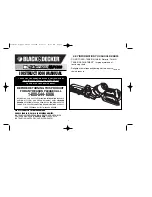
18
Montaje de la sierra en un banco de trabajo
Antes de utilizar la sierra, se debe montar firmemente en un banco
de trabajo u otro armazón rígido.
Utilice la base de la sierra para marcar y pretaladrar los agujeros de
montaje. Si la sierra se va a utilizar en una sola ubicación, sujétela
permanentemente a la superficie de trabajo, utilizando tornillos
para madera si se va a montar en madera. Use pernos, arandelas y
tuercas si la sierra se va a montar en metal.
Para reducir el ruido y las vibraciones, instale una almohadilla de
espuma blanda (no suministrada) entre la sierra de contornear y el
banco de trabajo.
¡Advertencia! Para reducir el riesgo de lesiones:
• Cuando transporte la sierra, sosténgala cerca del cuerpo
para evitar lesiones en la espalda. Doble las rodillas cuando
levante la sierra.
• Transporte la sierra por la base. No la transporte por el cable
de alimentación.
• Sujete firmemente la sierra en una posición en la que la gente
no se pueda parar, sentar o caminar detrás de ella. Los resi-
duos lanzados por la sierra podrían lastimar a las personas
que estén de pie, sentadas o caminando detrás de ella.
• Sujete firmemente la sierra sobre una superficie firme y
nivelada en la que no pueda oscilar y haya espacio adecuado
para manejar y soportar apropiadamente la pieza de trabajo.
Ajuste del pie del protector de la hoja (Fig. 7 y 8)
Cuando realice cortes en ángulo, el pie del protector de la hoja se
debe ajustar de manera que esté paralelo a la mesa y descanse en
posición plana sobre la pieza de trabajo.
1. Para ajustar el pie del protector de la hoja, afloje el tornillo
(2)
, incline el pie
(1)
de manera que esté paralelo a la mesa y
apriete el tornillo.
2. Afloje el pomo de ajuste de la altura
(3)
para subir o bajar el
pie hasta que descanse justo en la parte de arriba de la pieza
de trabajo. Apriete el pomo. No se requiere ensamblaje. Antes
de realizar ajustes, puede que quiera montar la sierra de
contornear en una superficie estable. Consulte “Montaje de la
sierra en un banco de trabajo”.
Ajuste del soplador de polvo (Fig. 9)
Para obtener los mejores resultados, el tubo del soplador de polvo
(4)
se debe ajustar para dirigir el aire tanto hacia la hoja como hacia
la pieza de trabajo.
Bench mounting the saw
Before operating the saw, it must be firmly mounted to a workbench
or another rigid frame.
Use the base of the saw to mark and pre-drill the mounting holes If
the saw is to be used in one location, permanently secure it to the
work surface using wood screws if mounting to wood. Use bolts,
washers, and nuts if mounting into metal.
To reduce noise and vibration, install a soft foam pad (not supplied)
between the scroll saw and the workbench.
Warning! To reduce the risk of injury:
•
When carrying the saw, hold it close to your body to avoid
injury to your back. Bend your knees when lifting the saw.
•
Carry the saw by the base. Do not carry the saw by the power
cord.
•
Secure the saw in a position where people cannot stand, sit,
or walk behind it. Debris thrown from the saw could injure
people standing, sitting, or walking behind it.
•
Secure the saw on a firm, level surface where the saw cannot
rock and there is adequate room for handling and properly
supporting the workpiece.
Blade guard foot adjustment (Fig. 7 and 8)
When cutting at angles, the blade guard foot should be adjusted so it
is parallel to the table and rests flat abovethe workpiece.
1. To adjust, loosen the screw
(2)
, tilt the foot
(1)
so it is parallel
to the table, and tighten the screw.
2. Loosen the height adjustment knob
(3)
to raise or lower the
foot until it just rests on top of the workpiece. Tighten the knob.
No assembly required. Prior to making adjustments you may want
to mount the scroll saw on a stable surface. See Bench mounting
the saw.
Adjusting the dust blower (Fig. 9)
For best results, the dust blower tube
(4)
should be adjusted to direct
air at both the blade and the workpiece.
2089_Manual_Skil_3335.indd 18
2089_Manual_Skil_3335.indd 18
10.02.10 14:19:38
10.02.10 14:19:38
















































